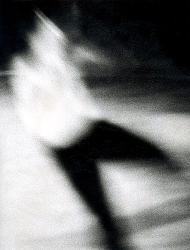


|
Motion...Repetition...Change...Evolution...The presumption of life itself. The sign of existence compared with the stone-like immobility of this inorganic world. Everything moves and everything repeats itself. From the very great to the very small and insignificant. Planets that rotate periodically around stable and bright suns. Atoms that move around pre-determined orbits of a nucleus. Blood that runs vigorously in the veins, bringing life to the cells. Days that follow nights in the endless cycle of time. Cycles that begin and end; the life cycle, the death cycle, the cycle of time...Time...the implacable companion of movement which exploits basic relations: the beginning and the end...Forming the current of 'events' and of emotions. Dance...Throughout the centuries, it has been man's expressive attempt to standardize and to codify this 'current.' Through his necessity of expression that creates the spiritual world, through his body's movement, it has become the most absolute and primitive way of expression and the most authentic one. An essential procedure for the conscious participation in the infinite and indestructible 'movement' that creates and sustains life. Photography...man's contemporary attempt to isolate -with the help of technology- and to break down certain components of this 'current' by capturing a flat static=motionless image. It interferes violently in the animated reality by trying to transform the image into a motionless object. Basically it kills it and it gives birth to it again. But it is perceived in a totally different way. By capturing the movement of dancing, photography tries to reproduce and to keep alive the complicated feelings which have already been expressed (consequently dead) by the dancer's harmonious movements. Indeed this makes more absolute and difficult the use of photography anywhere else. According to Aristotle, if art is to imitate, to copy life, then dancing is imitating the 'current' of life. Movements that carry messages which can be interpreted in a number of different ways and which the camera lens tries to trace. In doing so, the swinging limbs with the help of imagination and the rules of aesthetics are transformed. The human body in some places becomes part of nature, it reminds us of a bird or an animal; in others it becomes part of technology, a waxen doll - lifeless, dead. But it always carries forcefully the intensity of emotion, like the first, primitive movement of choreography, from which it has been cut off almost violently, by the intrusion of the lens. The fuzziness around the edges, the grain and the intense contrast make this division more dramatic and the transformation that follows more intimate. Therefore photography becomes twice a referral point: to the emotions created by the movement and to the recording of this expressive activity. It is worth mentioning that the photographs were taken during the 12th performance of the "Gala des Etoiles" at the open theatre of Thessaloniki, from a viewer's seat. They were taken without a tripod or a flash, so the 'viewing' was more direct and the images were not 'frozen' in order not to decompose the original feelings which dancing transmits. THESSALONIKI 1998 |






Copyright © 1997 / 98 Black & White Art Zone. All Rights Reserved.